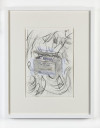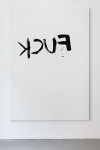
























Merlin Carpenter, Nicolas Ceccaldi, Jana Euler, Monika Jarecka, Tobias Kaspar, Dirk Meinzer, Buffy Summers, Jan Timme, Amelie von Wulffen
Coming of Age for Ages
Feelings of being beside oneself, of self-deprecation and revolving only around one’s ego, as well as rejection, romantic indulgence, social phobia, fandom, deviance and rebellion are usually associated with adolescence in the West. The reason is most likely that, at least from the perspective of smooth functioning, a certain immaturity, lability, embarrassment and self-love is attributed to them.
The exhibition is interested in these emotional states, passions, dispositions and poses because they not only characterise adolescence. When talk is of adolescent sentiments and gestures of “puberty”, we do not place them in a temporal context, in a certain phase between childhood and adulthood, but instead refer to a continuous or never-ending adolescence, to not wanting or not being able to grow up. Puberty as an attitude, so to speak.
“Pubertal” gestures and passions understood in this way should not be romanticised, however, but grasped, quite to the contrary, as deeply ambivalent phenomena. For apart from the productive aspects revealed in withdrawal, rejection and self-empowerment (whether they are intentional or not), an obstructive stance of this sort is usually also accompanied by moments of suffering in face of oneself and the world, of wanting too much or everything at once as well as of a speechlessness (felt at least) and inability to act. These can indeed be described as everyday horrors, as an ongoing struggle.
The exhibition “Coming of Age for Ages” brings together works in which either explicitly or implicitly “pubertal” gestures, passions and feelings appear, be it in the form of adoration, navel-gazing, refusal, provocation, pathos or paralysis. In some of the works on view, a distance is inscribed which at times takes on the form of irony, détournement, pastiche or parody, while other works owe precisely to such an “adolescent” stance as an artistic practice. What must also be considered, though, is whether the making of art (like any other self-centred production seeking recognition) is not already deeply “pubertal” as such in regard to its insolence and excessiveness.